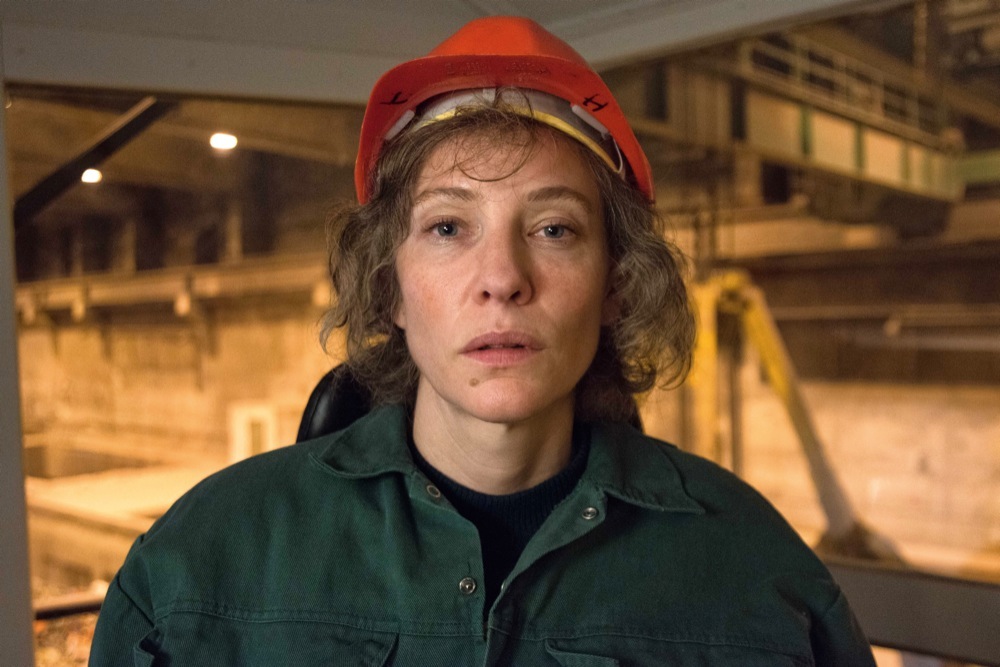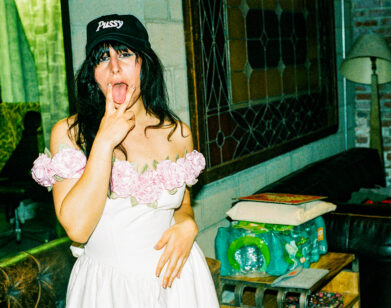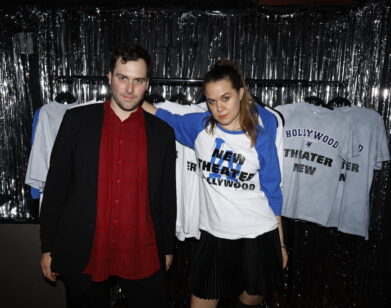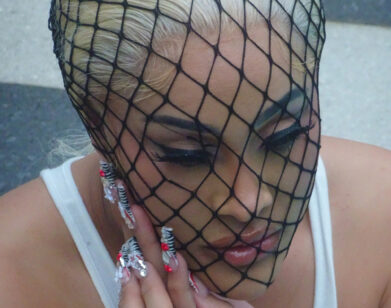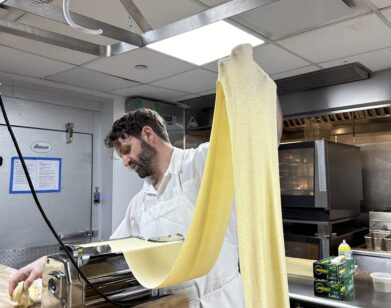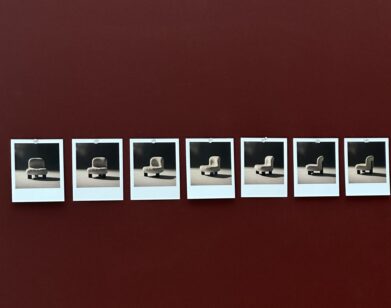Cate Blanchett, Beyond Character
“Chameleon” always feels like the inevitable mot juste when describing Cate Blanchett. In Manifesto, Blanchett’s latest starring vehicle in which she interprets 12 distinct personae—each one a “conduit” (as she calls them) for the recitation of around 60 spliced-up artist manifestos—her agile shape-shifting becomes the driving force. Throughout the film, she morphs from a primetime news anchor to a Russian choreographer to a schoolteacher, and from Marxism and Dadaism to Futurism and Fluxus. The result is a consciously disorienting experiment that’s variously provocative, surreal, and bitingly comical as it leaves us to draw our own conclusions.
Written, directed, and produced by German visual artist Julian Rosefeldt, Manifesto was originally exhibited in 2015 as a multi-panel video installation. Trading conventional narrative for poetic cadence in its feature-length form, it feels like a return to the European art-house films of the ’60s. The framing of these monologues into seemingly incongruous, banal scenarios distills the power of Blanchett’s performance down to the most minute details of her delivery. “It was a painstaking process to develop [scenarios] that allowed enough openness so that the manifesto wasn’t squashed by the situation, but was rather set free,” she reveals. “I didn’t think about them being characters, necessarily. It’s more that they do and say certain things within a framework or situation.”
Prior to Manifesto’s release at Film Forum in New York City last week, we caught up with Blanchett and Rosefeldt at the Tribeca Film Festival.
FRANK CHLUMSKY: You both met for the first time in Berlin in 2010. Did you develop the concept for this project collaboratively?
JULIAN ROSEFELDT: This project wouldn’t exist if we wouldn’t have met. Years before when we first met we had decided to do something together, and then it became intensely collaborative after I did research on all the manifesto texts. I sent her the work and some ideas for scenes, and she contributed other ideas for scenes. Then it was all about which text-collage goes with which scene and which character.
CATE BLANCHETT: [Julian] has sort of touched on this before in other work: the idea of mining the manifestos with his own provocations.
CHLUMSKY: Did you develop a concrete approach first, or did this come together in a more experimental fashion?
BLANCHETT: The whole thing was an experiment, an investigation; the architecture around the piece was very clear, but within that it allowed for an incredible amount of freedom.
ROSEFELDT: One thing that shaped it a lot was the time pressure. We had two weeks for everything, including preparations for makeup and costumes. We had 11 days together, which meant that we had to do a lot of work after we decided on the characters and combinations of scenes. “How is this going to look? What’s going to happen?” And then again it was very experimental, because Cate was thrown into cold water every morning. So were we, in a way. When you encounter another scenario every day, you don’t have time to get used to it. Every day is like starting from scratch, coming back to another reality.
CHLUMSKY: How does Berlin as a shooting location function in terms of the visual atmosphere?
ROSEFELDT: Berliners have a hard time saying that this is Berlin. My intention is that what you see is a big city, but not necessarily Berlin.
BLANCHETT: It’s elastic enough. At one point, we were talking about going outside the city down to Bavaria where we would use the forest to film, but that didn’t become logistically possible; we found more interesting locations closer to home.
ROSEFELDT: We had many more ideas for scenes than we were actually able to realize. In one she was supposed to be a climber in the mountains, playing with her echo. You know, when you climb a mountain you have this euphoria like, “Woo-hoo!”
BLANCHETT: There was another where she was a sports coach giving a pep talk. There were all these other really wonderful scenarios. [But] it wasn’t supposed to describe too closely what the manifesto was trying to get to—we didn’t want to make it too literal.
ROSEFELDT: Also the attitude of the character wasn’t supposed to be too close to that of an art-historian or someone who just teaches or talks about those manifestos. Whenever you have a situation where someone just talks to an audience, it could be easily understood as someone just talking about manifestos…
BLANCHETT: There was another one we talked about: having an after-hours cleaner in an art museum. So a lot of it would be interior monologue, but then we found that that would seem as if they were talking about the art museum. That then became the person who worked at the garbage facility.
ROSEFELDT: Other [scenarios] were just to too funny, too jokey. There was a sexual scene where the woman just talks and talks and the man that falls asleep—that was just a joke. Sometimes you didn’t find the texts that would match that, you needed something that just copes with that energy. That was difficult. You know a lot now! [laughs] You’re the first person to hear about all these unmade scenes.
CHLUMSKY: [laughs] Well, I did want to ask about the process of building characters. They seem to exist as avatars, or some kind of highly-stylized mouthpieces for these recontextualized and collaged manifestos. What is the experience like of interpreting a character whose dialogue is removed from their context?
BLANCHETT: Yes, it’s not often that the dialogue they’re saying is nonsensical, or that they’re trying to say something banal, prosaic, or domestic; they’re trying to do a domestic action—like explain something to someone, or ask someone to do something, like in the situation of the teacher—but they’re actually saying something that is not one-to-one with that acting action. It always felt sort of contrapuntal, this relationship between the text and the reality of the situation. I found that quite interesting; in a way I was trying to make energetic sense rather than intellectual sense, and hoped that that would produce an interesting tension in an audience that was expecting to make an intellectual connection on account of them being artist manifestos. But in fact they’re making a different connection. You feel it very acutely in the museum as a multi-channel work, where you see the mask come down and they all become, in a way, neutral masks. So the hair and makeup—the facade of the mask—is on, but the mask is dropped by the actor because they’re just being neutral. You’re then self-consciously aware that there’s an actor acting. I think you probably get that slightly less in [the film version].
CHLUMSKY: Why the decision, then, to turn it into a feature-length film from a visual installation?
ROSEFELDT: [looks at Blanchett and laughs] She knows I’ve not said this before, but there wasn’t a decision; there was an obligation to do this, in a way, because I needed to finance the installation. There was a TV channel that was willing to support the installation generously, but they of course needed something linear. I had to cope with that idea that it would have to take this shape. I also found this very exciting, because it’s a different audience. The museum can be a very self-selective audience.
CHLUMSKY: In sequencing the film linearly, was there a narrative logic you were trying to find?
ROSEFELDT: Visual narrative, I would say. There’s no story there, so we had to play with the tricks of filmmaking, adding up music, trusting that rhythm, speed, and edits would perfectly match with the images. The wonderful thing is that we had the film, because we wanted things to happen at the same time in different parts of the room like the spiral staircase, or two children playing in a circle. Through the edits these cuts became directly connected to each other: the stock exchange, which you see in a wide angle, cuts directly to the opener of the single mother and this kind of suburban housing complex where she lives. It was nice to see that thing that we had instinctively had shot for the installation worked so well as edits or transitions for the film.
CHLUMSKY: Which scenarios do you enjoy most?
ROSEFELDT: I would say the teacher, I think. One sort of contains the recipe of the entire project, but mostly because I like the hope in it. The children are there, and they will have to deal with whatever we do and carry this thought into the future. Besides, it’s very funny. [whispering, pointing to Blanchett] She likes the newsreader best [laughs].
BLANCHETT: I do also like the mashup of the manifestos with the Fluxus, in the scenario with the choreographer. I find that text very provocative.
ROSEFELDT: That’s interesting because it’s a very complicated collage. There’s feminism and there’s Fluxus.
CHLUSMKY: What do you feel the collaging of the manifestos does to their effect? Does it blow-up their significance and expose how conflated they can be? Does it reveal something entirely different?
ROSEFELDT: It’s certainly not mockery. I’ve been asked before if I’m making fun of those manifestos. The humor in the piece deals with the self-ironic aspect of the manifesto. We often forget that because we treat them as masterpieces. Humor is often forgotten by art historians and art critics when thinking about the work. Every piece of art that’s living on at the MoMA or something is monumental in its meaning, but when it was created, it wasn’t at all that. Very often these texts were written before the art was actually there. With the editing, we had different many ideas. It was driven by sympathy between the many voices but disagreement between the ideas as well. So inside you see a lot of controversy, just as in real life.
MANIFESTO IS CURRENTLY PLAYING AT FILM FORUM IN NEW YORK CITY.

